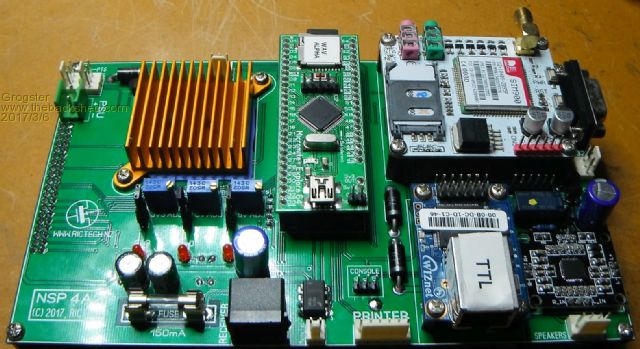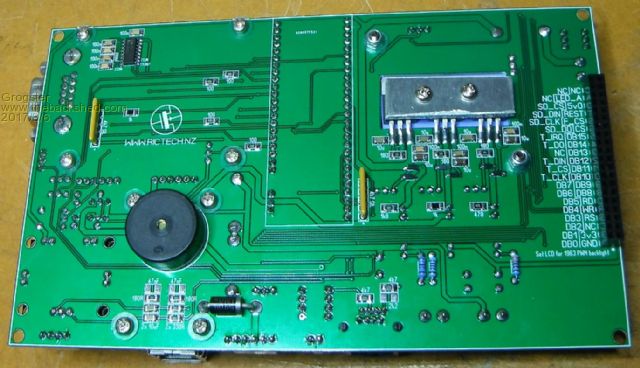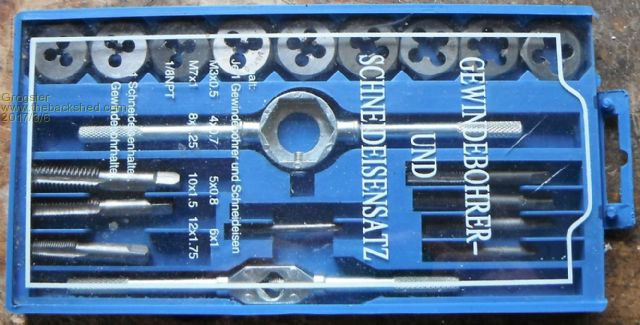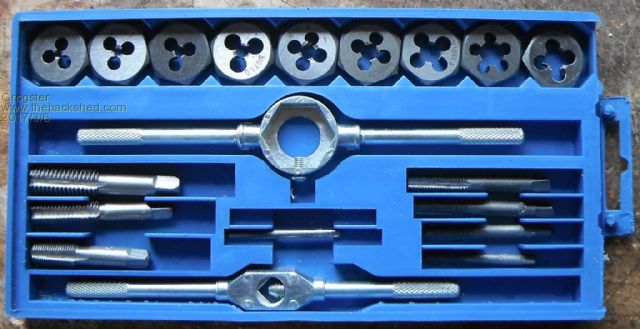
|

|
Forum Index : Microcontroller and PC projects : Cutting 3mm threads....
| Page 1 of 3 |
|||||
| Author | Message | ||||
Grogster Admin Group Joined: 31/12/2012 Location: New ZealandPosts: 9796 |
Does anyone here have a link to a GOOD QUALITY, very strong 3mm thread cutter? I have already broken two of the ones I have here - cheap and nasty though, so I kinda expected it. Even at 3mm, you have to apply quite a bit of torque to cut the thread through 5mm thick aluminium, and the cheap thread cutters I have just shear off - totally useless. The ones I have been using just snap anyway, even with very slow speed and I even tried using cutting oil too. Part of the problem is that 3mm is a very small thread to cut, and so the cutter itself has to be VERY strong to stop it snapping under the strain. So, I was kinda hoping that someone here might be able to link me to a good quality and very strong one that WON'T shear off while cutting the thread through the hole, or perhaps suggest a different method for doing the same thing. Have to cut a thread, as it is a finned heatsink, and you can't get at the other side of it to use a nut and bolt arrangement, so you really do have to cut a thread and use 3mm bolts. Can't use 4mm - not enough room, has to be 3mm. Can't find any self-tappers that are long and skinny or I could use them perhaps. Anyone got any bright ideas? Smoke makes things work. When the smoke gets out, it stops! |
||||
TassyJim Guru Joined: 07/08/2011 Location: AustraliaPosts: 6399 |
The brand I usually go for is P&N Use plenty of cutting fluid. Even WD40 is OK. Tap slowly with plenty of backing off. Half turn forward, quarter turn back. Always start with the full taper tap and then the intermediate. Finally the no-taper tap if they are blind holes. There will be others who have had a lot more experience than I have had and hopefully can give more advice. It's a bugger when its the last hole that the tap breaks of in... Jim Edit: If it's a long hole, I would probably cheat and use a 7/64in drill bit instead of 2.5mm. VK7JH MMedit |
||||
MicroBlocks Guru Joined: 12/05/2012 Location: ThailandPosts: 2209 |
Some cutting fluid will help, but the sure way is to use a slightly larger drill so the taps do not need to remove as much material. 5mm will give enough threads for a secure fit. If that is not an option then use a "machine tap". Machine taps have different geometry that evacuates chips better, so less change of recutting chips. Also critical especially for small diameter is to guide the tap. A drill press would be good for that. Microblocks. Build with logic. |
||||
| MM_Wombat Senior Member Joined: 12/12/2011 Location: AustraliaPosts: 139 |
I used that method when I tapped a 1.73 mm thread when making a 3d print nozzle using an airbrush 0.2mm nozzle. Slow and steady, wins the race. I went a little further than Tassyjim, doing half turn in half turn out. Very small tap, I think the thread pitch was 0.24 mm . MMWombat Keep plugging away, it is fun learning But can be expensive (if you keep blowing things up). Maximite, ColourMaximite, MM+ |
||||
palcal Guru Joined: 12/10/2011 Location: AustraliaPosts: 2027 |
I do it exactly the same as Tassy Jim, that's the way I was taught when I did metal work at school. I tapped a large heat sink not long ago for a battery charger and had no trouble at all. Maybe if you tell us exactly how you are doing it we can tell you where you are going wrong. Paul. "It is better to be ignorant and ask a stupid question than to be plain Stupid and not ask at all" |
||||
| Phil23 Guru Joined: 27/03/2016 Location: AustraliaPosts: 1667 |
Yeah second P&N as quality taps & dies. Also Sutton tools. Basically all the cheap stuff will be just high carbon steel. Anything decent will be High Speed Steel. As far as a cutting fluid is concerned, Kerosene is a preferred lubricant for tapping aluminium. The other alternative is a product called Trefolex. It's especially made for the job. It's available in either liquid, spray or paste form. Winding the tap in reverse is called "Humouring" in the old days. As you wind the tap in the swarf it creates curls up within the hole, winding the tap backward serves to break it off so the cutting swarf can be pushed free as it build up. If you still find the taper tap getting too tight in the 5mm depth, cut just 2 or 3 turns with the taper, then use the intermediate, then the plug, but all for the dame number of turns. Then go back thru that process again. Cutting more than One times the diameter in depth, places a fair load on ant size tap; more length engaged in cutting = more friction. Cheers. |
||||
| Phil23 Guru Joined: 27/03/2016 Location: AustraliaPosts: 1667 |
Yes, definitely do that a lot at times. Often hard to keep them square when starting. |
||||
| Phil23 Guru Joined: 27/03/2016 Location: AustraliaPosts: 1667 |
A photo might help with that. Easier to visualise alternatives. Maybe some sort of pressure plate or spring type clip. |
||||
| IanT Senior Member Joined: 29/11/2016 Location: United KingdomPosts: 120 |
Grogster, I am a fairly experienced machinist and this should be fairly straightforward thing to do, so perhaps I can offer a few words of advice. There are three areas that will help. As has been mentioned, any hole to be 'tapped' will require a 'tapping' sized hole to be drilled first - and although there are tables of tapping drills published, these are usually for industrial use and have high % thread engagements, whereas much lower thread engagements will not be significantly weaker - and much easier to cut. I'm not at home at the moment, so do not have my tables to hand. However for smaller threads, I normally use a 65% engagement/tapping drill size (e.g. a larger drill than normally stated). I will look this up (tapping drill for 3mm) later today (UK time) when I get back. Taps normally come in sets of three, starter, 2nd and 3rd - which for deeper/longer holes give a staged operation, thereby reducing the initial cutting strain. For shallow/blind holes, this is not always useful or possible - and I'm not sure exactly what access you have in this case. Finally, and the advice that I suspect will help the most - small taps must enter the work exactly central/upright to the hole, otherwise they will break! There are several ways to ensure this - but without knowing exactly what machinery/equipment you have available, it's hard to advise. So, the simplest method, is to use a 'guide' which is simply a suitable plate or cylinder drilled through 'clearance' (a little over nominal size - e.g. 3.1mm in this case) which will guide your tap in upright. Hope this helps - not often I can do so in this company. :-) Regards, IanT |
||||
bigmik Guru Joined: 20/06/2011 Location: AustraliaPosts: 2973 |
Gray Grogster, The first 9.5 years of my working life was as a fitter and turner.. That was nearly 32 years ago.. You have been given all the answers above so I won't go into too much detail.. I suspect you are trying to tap the thread with a bench drill... Not a good idea.. You MUST break the swarf (metal scrap cut out) or else the tap will jam. Do NOT forget to back off and turn backwards very often. You MUST use a good brand of tap and it MUST be high speed steel (HSS) good brands I have used are P&N, SUTTONS, FROST.. These are always silver... Never use BLACK CHEAPO taps these are always just hardened steel and are prone to snap, they also do not have a good Rake to cut the swarf I would just use thin machine oil but maybe there are better lubricants. I have successfully cut many a 3mm thread... It is not that bad but you need all the above working for you to get it right.. Do not rush the job.. I have not broken a tap since my apprentice days. Regards, Mick Mick's uMite Stuff can be found >>> HERE (Kindly hosted by Dontronics) <<< |
||||
Grogster Admin Group Joined: 31/12/2012 Location: New ZealandPosts: 9796 |
Wow!  A few more replies then I thought I would get in one evening! A few more replies then I thought I would get in one evening!Yeah, I was just using the "Black" metal taps, and they are bloody useless. They come as one final thread size only - no starter, no 2nd, no 3rd, just the final 3mm size and that's it. They are cheap rubbish, and I fully acknowledge that these are probably best thrown into the skip right now..... I will see if I can find any of those brands on the web - hopefully one of them has a webstore. Not sure where I could find something precision like this here in NZ, cos our hardware stores only have the cheap crap.  So, in other words, I was trying to tap the 3mm thread directly, in ONE operation, with ONE tap, which was the full 3mm size. Obviously, this is NOT how it should be done, so I need something of better quality and precision, so I can do holes like this correctly from now on. EDIT: P&N have a branch in NZ, so I will ring them tomorrow. They do a 3-bit HSS set for 3mm and 4mm(taper/intermediate/bottoming), so I will probably get both sets, as I often need 4mm threads too. I have a drill-press, but even at the slowest speed, I think it would be way too fast for this kind of thing, so probably has to be done by hand. With a 3-stage set, it should be much easier to do. Smoke makes things work. When the smoke gets out, it stops! |
||||
| Paul_L Guru Joined: 03/03/2016 Location: United StatesPosts: 769 |
Grogster, You don't specify what thread pitch you are cutting, but these are the recommended tap drill sizes with the closest American equivalents for the common threads and materials for 3 mm threads. Clamping a heat sink is not a high tension application so it is reasonable to cut threads that do not engage fully. 50% should be plenty. pitch 75% thread 50% thread close clearance standard clearance 0.6 mm 2.40 mm #41 2.60 mm #37 3.15 1/8 3.30 #30 0.5 mm 2.50 mm #39 2.70 mm #36 3.15 1/8 3.30 #30 The lubricant you use has to be very slippery and has to carry the cuttings off in suspension but it does not have to withstand high temperature for hand tapping. A high viscosity semi-solid probably works as well as a liquid. In order of preference I would try; (1) silicone grease, (2) black ball joint grease with molybdinum sulfide particles in suspension, (3) solidified bacon grease, (4) lanolin enriched hand soap, (5) anything else that sticks to your fingers and makes it difficult to pick up and clamp the tap in a chuck. Back out the tap frequently to clear the chips produced while they are still very small. If you keep cutting continuously the chips can get very big. Paul in NY |
||||
| Paul_L Guru Joined: 03/03/2016 Location: United StatesPosts: 769 |
Grogster, Buy the needed drill sizes from P&N if they sell them. Since you have a drill press you can use it to hold and guide the tap but turn the spindle by hand by pulling on the belt! Paul in NY |
||||
Grogster Admin Group Joined: 31/12/2012 Location: New ZealandPosts: 9796 |
Bloody hell!!! Now THERE'S and idea, Paul!!!  I will also enquire about the drill bits to suit the taps too. Smoke makes things work. When the smoke gets out, it stops! |
||||
| IanT Senior Member Joined: 29/11/2016 Location: United KingdomPosts: 120 |
Hi Grogster, Just back - long drive, so it's coffee time! Being soft, aluminium has a higher recommended % engagement than (say) mild steel - being 65% for wrought aluminium and 75% for cast aluminium. A coarser thread is also normally better but in this small sized, not really an option. A 3mm metric tap will (most likely)have a 0.5mm pitch thread. For 65% TE - a 2.65mm tapping drill is required and for 75% TE a 2.6mm tapping drill. I'm still not clear if you can "tap through" or not (if it's a closed hole you cannot do so of course) - but if you can, then the 'starter' (No1) tap will usually have a full thread at the back end, so will be the only one required - IF you can screw/tap it fully home. In my experience, the main reason for breaking taps is that they are not aligned with the hole properly. Thinking about this earlier, I also wondered if you were drilling your holes true but seeing your comment about having a drill press, assume you are. No point in holding the tap upright if the hole is skewed! With regards to lubricant, I use Trefolex (as does someone else here I see) on everything except cast iron. An alternative for aluminium is WD-40 - but the main thing is to keep the tap flutes clear - so frequent withdrawal and cleaning/flushing will help. I don't know what "black" taps are - but they don't sound too good. A HSS tap will last a long time if not abused... Hope this helps. Regards, IanT |
||||
| Phil23 Guru Joined: 27/03/2016 Location: AustraliaPosts: 1667 |
When it's the smaller of taps, under 6mm. I actually flick the front belt off the spindle pulley then just turn the chuck by hand. Found that you get much better feel of the tap loading up without all the inertia of the pulleys belts & motor. Drilling size for metric is generally quoted as diameter - pitch. IE 3mm 0.5 pitch drill size is 2.5mm. |
||||
| Paul_L Guru Joined: 03/03/2016 Location: United StatesPosts: 769 |
Grogster, Whoops, I forgot that html would mess with my formatting yesterday. Here's that table again. close standard pitch 75% thread 50% thread clearance clearance 0.6mm 2.40mm #41 2.60mm #37 3.15mm 1/8" 3.30mm #30 0.5mm 2.50mm #39 2.70mm #36 3.15mm 1/8" 3.30mm #30 Paul in NY |
||||
Grogster Admin Group Joined: 31/12/2012 Location: New ZealandPosts: 9796 |
[Quote=IanT]I'm still not clear if you can "tap through" or not (if it's a closed hole you cannot do so of course) - but if you can, then the 'starter' (No1) tap will usually have a full thread at the back end, so will be the only one required - IF you can screw/tap it fully home.[/Quote] Closed hole in this case. Finned heatsink:   There is a fan that goes on the top of the heatsink, but this is not shown. The two 3mm bolts secure the three regulator IC's to the bottom of the heatsink, using a bit of 3mm aluminium plate as a load-spreader/clamp thing. Naturally, there is also a heatsink gasket under the regs so the tabs don't short on the heatsink, as they are 350T regulators, and the tabs are at output voltage. @ Phil23 - good idea. I will use that method next time. This is the crappy set I have:   Smoke makes things work. When the smoke gets out, it stops! |
||||
| matherp Guru Joined: 11/12/2012 Location: United KingdomPosts: 10742 |
Tapping into these is a guaranteed way to break taps unless you can get the drill to come out exactly between the fins. The drill goes through but flexes as it hit one side of the fin i.e. the hole isn't true. The tap tries to follow and breaks - been there done that - got the tee-shirt  |
||||
Grogster Admin Group Joined: 31/12/2012 Location: New ZealandPosts: 9796 |
Oh dear...... Can you sell me my own T-shirt then?  I never broke the drill bit, it was just the tap, and that was only cos it got so tight - but I get the feeling from this thread thus far, that I was actually doing it wrong. Should have been backing it off, then going back in. I wasn't doing that, so....snap! Smoke makes things work. When the smoke gets out, it stops! |
||||
| Page 1 of 3 |
|||||
| The Back Shed's forum code is written, and hosted, in Australia. | © JAQ Software 2025 |